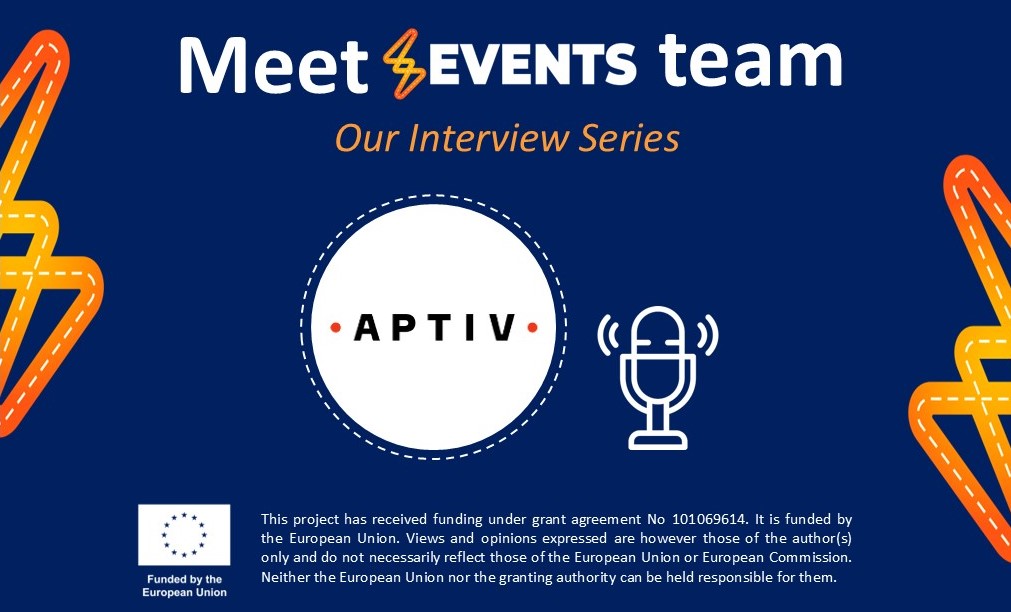
Meet APTIV
Aptiv is a global technology company that designs, develops and manufactures software and hardware solutions to enable a safer, greener, and more connected future of mobility. Our solutions help automotive OEMs around the world to create vehicles with advanced safety systems, electrified architectures and intelligent connectivity.
We envision a world with zero fatalities, zero injuries, zero accidents – and zero emissions. A world where software and cloud connectivity enable vehicles to gain new features every day. With solutions developed sustainably, in a global culture that adheres to a core set of values.
As a global technology leader, Aptiv boasts a massive presence, with a workforce of over 200,000 individuals, operating across 138 manufacturing facilities, and 13 technical centers, spanning 50 countries around the world. In the EVENTS Project, Aptiv is represented by 2 technical center members from APTIV Services Deutschland GmbH and APTIV Holdings France.
The members contribute in the following ways:
– Project management,
– cross System Architecture team for system topics,
– functional safety team, for leading the specific FuSa study and associated protocols,
– and a system integration team for all activities linked to bench and prototype.
These teams are a part of our Global Product Organization (GPO), which defines and develops the Aptiv ADAS feature platform.
What is your role and involvement in the EVENTS project?
Aptiv plays several roles within the EVENTS project, two key areas include:
1. First, our main objective is to make roads safer by preventing accidents caused by debris. To achieve this, we’re working on enhancing Aptiv’s perception systems and algorithms. We’re leveraging our latest radar technology, paired with a new Machine Learning module, to push beyond current performance limits in detecting road debris. This will not only enhance safety, but also prepare us for the next steps in autonomous vehicle development.
2. Next, we’re contributing to the functional safety in the project. Aptiv brings a wealth of expertise in system development, across various OEMs, and system architectures. As part of the consortium, we lead the functional safety studies using the V-model approach—proposing the steps for safety analysis (on the left side of the V) and then defining a test protocol for safety data collection (on the right side of the V).
How do you ensure that the project is aligned with industry needs and standards in the field of CAVs?
EVENTS partners include both academic and industry players, all contributing to the evolution of the automotive sector. At Aptiv, our solutions are designed to address the challenges all major OEMs face as we move toward autonomous driving.
Our experiment in EVENTS is tied directly to a common use case in the automotive industry—road debris. During our literature review, specifically looking at the “Prevalence of Motor Vehicle Crashes Involving Road Debris” report (Tefft, August 2016), it became clear that on U.S. Interstate highways, debris-related crashes occur four times more frequently than those without debris. While other technologies like lidar and cameras also play a role in Connected and Automated Vehicles, we saw the EVENTS project as an opportunity to push our radar technology to new heights, offering the best capabilities for the next generation of perception systems.
In terms of functional safety, we align with the latest regulations (like DCAS and ALKS) and standards (ISO 26262, ISO 21448 for SOTIF). Leveraging our experience collaborating with OEMs, we bring forth innovative solutions that consistently push the boundaries of the automotive industry’s latest advancements, staying at the forefront of technological excellence.
Additionally, our ability to integrate hardware and software into prototype vehicles and test the full system supports the V-cycle development process expected in the EVENTS project. And lastly, our experience managing automotive projects helps ensure we contribute efficiently across the EVENTS work packages.
What improvements do you think the automotive industry needs to support new driving technologies?
The future of the automotive industry is moving toward new driving experiences, such as hands-off and eyes-off capabilities, which require safety standards on par with human decision-making. Additionally, vehicles are becoming a part of a more connected ecosystem—through over-the-air (OTA) updates, cloud integration, and V2X communication—which demands continuous improvements in vehicle architecture (like Software Defined Vehicles) to introduce new features, ensure data protection, and maintain vehicle value.
The EVENTS project is tackling these challenges by improving environmental perception and developing self-assessment methodologies to enhance decision-making in various driving scenarios.
In short, the automotive industry needs to shift from focusing on specific domains (chassis, powertrain, multimedia, etc.) to embracing a global architecture capable of rapid response to changes across the ecosystem—whether that involves open-source features, OTA updates, or protecting against cyberattacks. Collaboration among universities, OEMs, and suppliers will be key to driving this transformation forward.
Anything else you would like to mention or highlight?
We would like to express our gratitude to all the partners involved in the EVENTS project. The open discussions and knowledge-sharing during the meetings have been incredibly valuable. For Aptiv, this project represents an opportunity to bring new solutions to life in a way that’s different from our usual projects, and we’re learning a lot from the feedback we receive during these sessions.
We’ve had similar experiences in previous funded projects, and we hope to continue contributing to future initiatives as well.
Philippe Troia, Senior Director,
Safety Architecture, Regulation & Standards, Public Fundings and Aptiv Holding France Establishments Director



